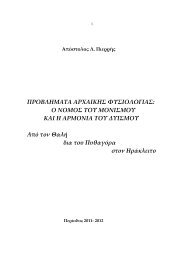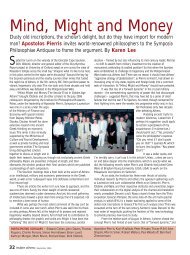chapter 10 the monism of darkness and the dualism of limit and ...
chapter 10 the monism of darkness and the dualism of limit and ...
chapter 10 the monism of darkness and the dualism of limit and ...
You also want an ePaper? Increase the reach of your titles
YUMPU automatically turns print PDFs into web optimized ePapers that Google loves.
56 CHAPTER <strong>10</strong><br />
Wind now belongs to <strong>the</strong> Second Principle as passion for <strong>the</strong><br />
conception <strong>of</strong> luminous spirit. The Wind as principle <strong>of</strong> motion in <strong>the</strong><br />
Second Principle is aroused, to be sure, by virtue <strong>of</strong> <strong>the</strong> desire for <strong>the</strong><br />
first principle <strong>and</strong> its measured mobility, but is, none<strong>the</strong>less, <strong>the</strong><br />
proximate creative cause <strong>of</strong> <strong>the</strong> World’s order. The Wind is not,<br />
however, an intrinsic factor <strong>of</strong> <strong>the</strong> Second Principle per se.<br />
5. In contrast to such a view, Greek Dualism in its early phase<br />
considered <strong>the</strong> root <strong>of</strong> mobility to belong intrinsically to <strong>the</strong> disorderly<br />
that is peculiar to <strong>the</strong> Un<strong>limit</strong>ed principle (Indeterminacy). This is, for<br />
instance, <strong>the</strong> eternal motion <strong>of</strong> Anaxim<strong>and</strong>er’s Unbounded (12 A9<br />
<strong>and</strong> 12 DK), its essential character that renders it in itself fertile: <strong>the</strong><br />
basic pairs <strong>of</strong> opposites that constitute <strong>the</strong> World are secreted<br />
<strong>the</strong>refrom (cf. below, Chapter 12, n. 41). We meet with a similar<br />
problematic, albeit undecisive or ra<strong>the</strong>r hospitable to opposite<br />
directions, in <strong>the</strong> Hermoupolitic Cosmogony. The situation that is<br />
prior to cosmic creation is expressed by <strong>the</strong> Ogdoad (<strong>the</strong> very first<br />
deity <strong>and</strong> group <strong>of</strong> deities), i.e. four couples <strong>of</strong> divinities which denote,<br />
by means <strong>of</strong> <strong>the</strong> polarity between <strong>the</strong> male <strong>and</strong> <strong>the</strong> female, four<br />
fundamental aspects <strong>of</strong> <strong>the</strong> pre-universe: Nun <strong>and</strong> Naunet (primordial<br />
water), Heh <strong>and</strong> Hehet (spatial un<strong>limit</strong>edness followed by <strong>the</strong><br />
determinative ‘water’), Kek <strong>and</strong> Keket (Darkness’ abyss with <strong>the</strong><br />
determinative ‘night’), Amun <strong>and</strong> Amaunet (<strong>the</strong> latent, <strong>the</strong> Hidden,<br />
<strong>the</strong> unknown); v. e.g. Schwabl, Weltschoepfung in PW col. 1501; M.<br />
Eliade (ed.) Die Schoepfungsmy<strong>the</strong>n pp. 72-73 15 . According to later<br />
Egyptian sources, <strong>the</strong> last couple was substituted by Niu <strong>and</strong> Nit (<strong>the</strong><br />
nothing, negation, void). V. Bonnet, Reallexicon der Aegyptischen<br />
Religionsgeschichte, s.v. Ach<strong>the</strong>it, p. 5. In this case, <strong>the</strong> couple Amun-<br />
Amaunet was conceived <strong>of</strong> as <strong>the</strong> syn<strong>the</strong>tic hypostasis <strong>of</strong> primordial<br />
Odgoad (a fact that satisfied simultaneously both <strong>the</strong> religious feeling<br />
<strong>and</strong> <strong>the</strong> political importance <strong>and</strong> royal significance <strong>of</strong> Thebes after <strong>the</strong><br />
ascent <strong>of</strong> <strong>the</strong> local deity to <strong>the</strong> supreme rank). Fur<strong>the</strong>rmore, Amun<br />
(who was known as Ammon in <strong>the</strong> Greek world <strong>and</strong> was indentified<br />
with Zeus) was regarded, when identified with Ptah <strong>of</strong> <strong>the</strong> Memphitic<br />
Theology, as <strong>the</strong> Procreator <strong>of</strong> <strong>the</strong> primordial Ogdoad, but also, in his<br />
hypostatic identification with <strong>the</strong> Sun, as <strong>the</strong> Son <strong>and</strong> Semen <strong>of</strong> <strong>the</strong><br />
Ogdoad (v. Bonnet op. cit. s.v. Amun pp. 34-5). Amun’s fundamental<br />
attribute consists in hiddenness: he is <strong>the</strong> god that lies hidden <strong>and</strong>










